
17 Sep Artist Interview: Walpa D’Mark
Prior to his upcoming show opening at Mount Saint Mary’s University in Los Angeles, titled My Little Narrative, at the Jose Drudis-Biada Art Gallery from October 3rd to November 11th. The OC Art Blog had the opportunity to meet with Walpa D’Mark who’s self-reflective paintings use figuration and abstraction, historical and popular references that intersect between Nicaraguan and American history and politics. D’Mark has exhibited throughout L.A., including at Track 16, Mark Moore Gallery, Coagula Curatorial, and Torrance Art Museum. Internationally, he has exhibited in South Korea, Mexico, and Germany. He is a Senior Adjunct Professor at the University of La Verne, and Lecturer at Loyola Marymount University. He has BFA in Drawing and Painting from California State University, Long Beach, and an MFA in Painting from Claremont Graduate University. Lets meet Walpa.
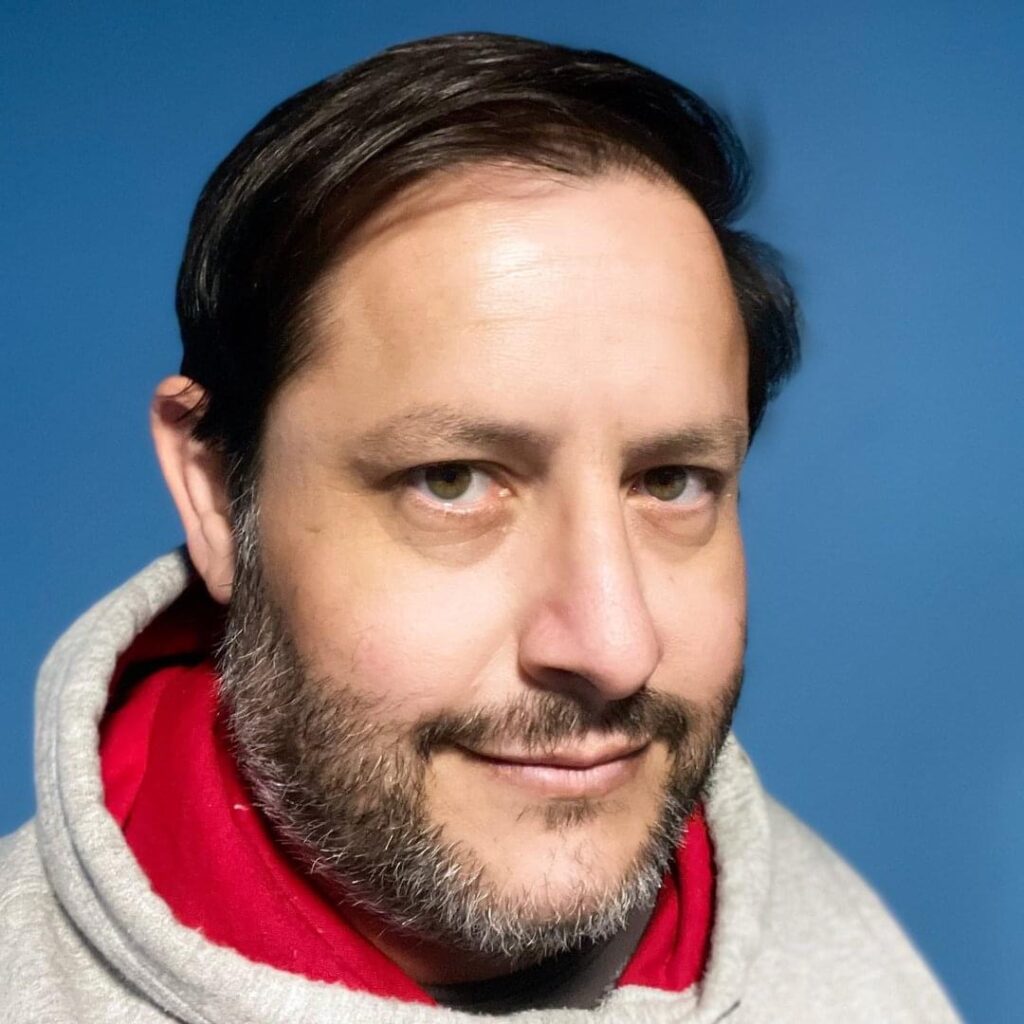
How did you first get into painting, and what has kept you passionate about it over the
years?
We immigrated as political asylum refugees from Nicaragua in 1982 because of a revolutionary war that started in 1979. I was a nervous little kid, I had seen too much, and was naturally sensitive. In elementary, I was in ESL, I had a stutter, and normality was really hard for me. I probably had PTSD. When I was in the third grade, my class went on a field trip to the Huntington, and I remember having an emotional moment when I saw the Blue Boy by Gainsborough. I wasn’t paying attention to the docent, and obviously, I had no idea about art history. Thank goodness. I was struck by what seemed to me was a strong boy in a dark overcast landscape, with all those dark colors, and that windy cold background. He seemed confident, and that really shocked me. It was a real feeling of SHOCK! I wanted that confidence because I felt weak and vulnerable as a young kid.
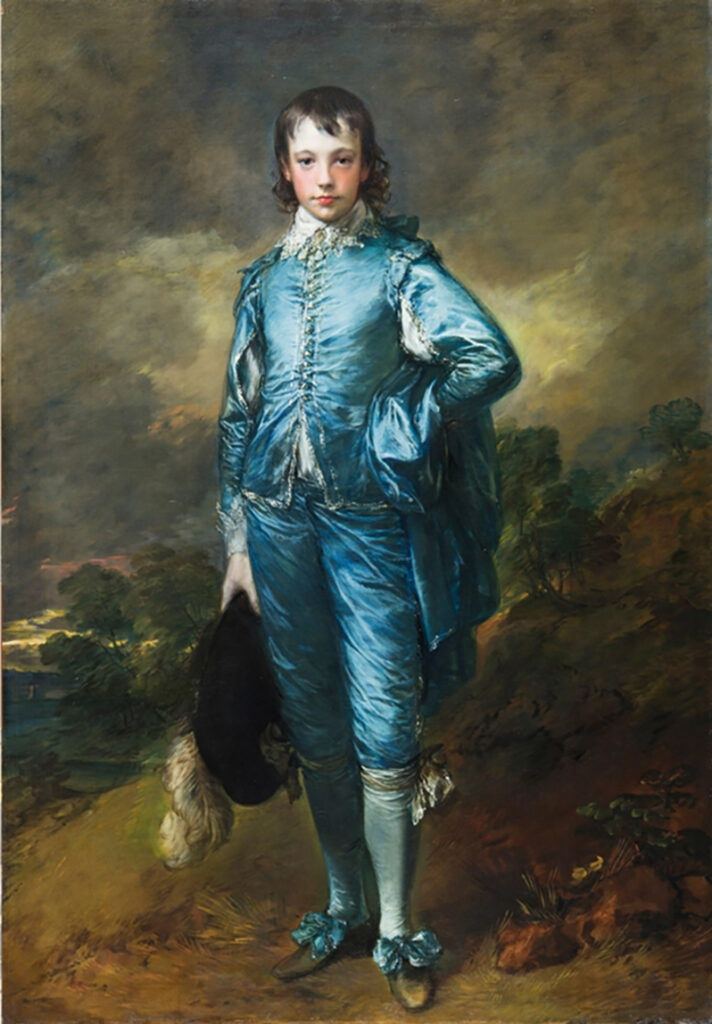
The second impression I had was, “what the heck is this object I’m looking at?” We had been walking through the collection already, but it was Blue Boy that got me. I thought about that painting object, and it really captured my imagination. How did this object make me have a reaction? I remember not long after, I told my dad that I wanted to be an artist. He started buying me white paper, comic books, and even a drawing table, and I began drawing. In the 4th grade, there was a little art project that I knew was going to be displayed in the cafeteria, so I drew gumby in Blue Boy’s stance, colored it in with color pencils, and was so happy to see it up in the cafeteria. It was cool to see the drawing itself, but it really felt like I had achieved some kind of expression. For better or for worse, that started my interest. It’s cliche, but that’s what happened. I grew up in Torrance, and was fortunate to fellowship with artistic friends. We kept ourselves involved with painting, comic books, theater, and music. I just kept that going. Now I’m old, haha.
How would you describe your personal artistic style and philosophy?
I guess I’m into post modernism and expression. In undergrad, I was introduced to post-modern philosopher Lyotard (really briefly, but it stuck). “Simplifying to the extreme, I define postmodernism as Incredulity toward metanarratives.” A Metanarrative provides a schematic world view upon which an individual’s experiences and perceptions may be
ordered. They can be found in cultural, religious, political and societal structures. Lyotard wanted small localized narratives, or what he termed petit recit, or little narratives. Because our society is now pluralistic, he believed in many little narratives.
That went along with other ideas I was being introduced to, such as multiculturalism, the melting pot, juxtaposition, and meshing. I was also introduced to Neitche, although it was hard to read and retain or grasp at first, I did catch up to some ideas. Such as that god is dead, which really meant that big narratives that shape our values are dead, how truth is meh, and how nihilism is something we will have to acknowledge and overcome in post modernity, and maybe how to overcome that through transforming from a camel to a lion and finally into a child…and maybe how our human evolutionary destiny is to become supermen, like Joe Rogan. Haha.
I was also learning about how faith can be used for political agendas. I had taken a class on Liberation Theology, and Nicaragua was an example, and it opened my eyes to how the catholic church in Nicaragau was used to push the idea of Christ as freedom fighter for the poor, and of course they painted him as a communist. Their Christ looked like Che…how gross.
At the time, I was serving and ending 6 years in the Army National Guard, and was struggling with my Christian faith. Before I go on, I am patriotic and Christian. Okay. I love the people that I served with in the Army National Guard, it is one of my favorite memories. Long story short, I was not allowed to continue serving because of my political asylum
status. I was planning to make that my profession. You could say that my metanarratives were crumbling around me. Also, a lot of that trauma from my youth was catching up to me and I wasn’t the best version of myself. In undergrad, I painted through the lens of a kid that was looking for spirituality or freedom in Art, and only saw an absurd existence. 2, 3
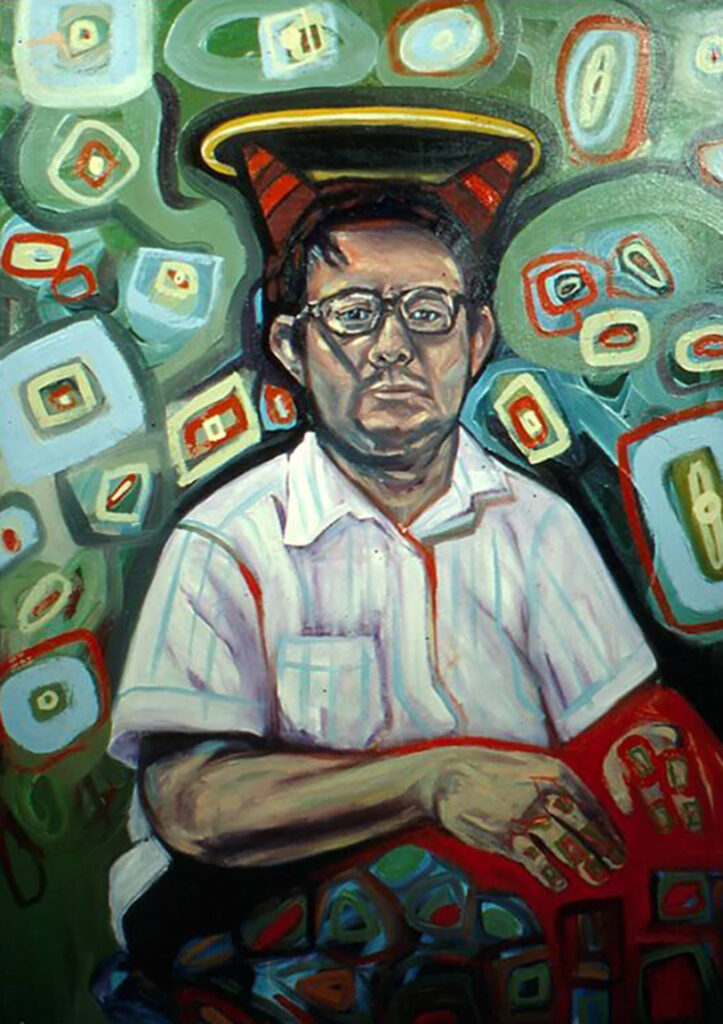
Self Portrait, Oil on Canvas, 36×48 Inches, 2002
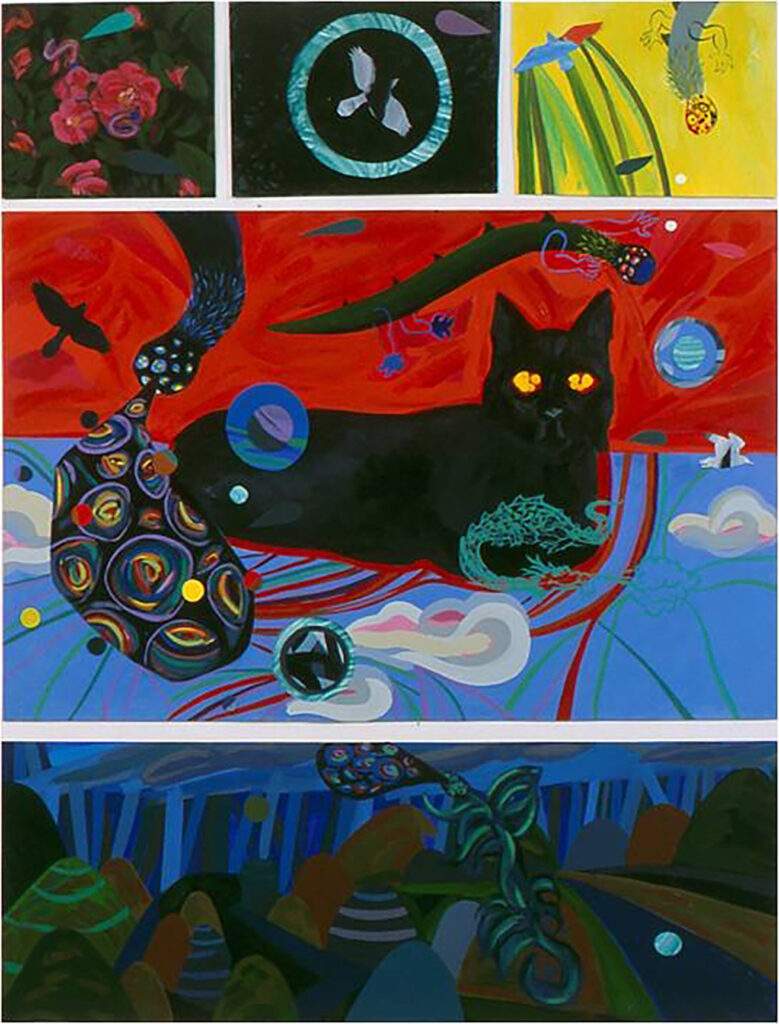
Enigmatic, Acrylic on Yupo Paper, Dimensions Vary, 2005
I went on to think about the metanarrative in grad school. In my first year, I attempted to paint a metanarrative of my own called Hallucinations and Hallelujahs. The narrative
starred a character named Wilt, who was a metaphor of my ego and the god figure of the paintings. Wilt was trying to create a sweet and perfect world made of sugar. It kinda visually read like genesis…in the beginning, Wilt created…That world soon fell apart when he realized he was indeed not God, and was in fact just a painting. Wilt ran and hid. Sadly, I found that Art was just another Metanarrative. The whole process felt like Ralphie in A Christmas Story trying to decipher the message only to find out that it was a commercial for ovaltine. In my second year of grad school, my thesis show was called ambiguous and sloppy, which were existential poetic moments of the world Wilt left behind.
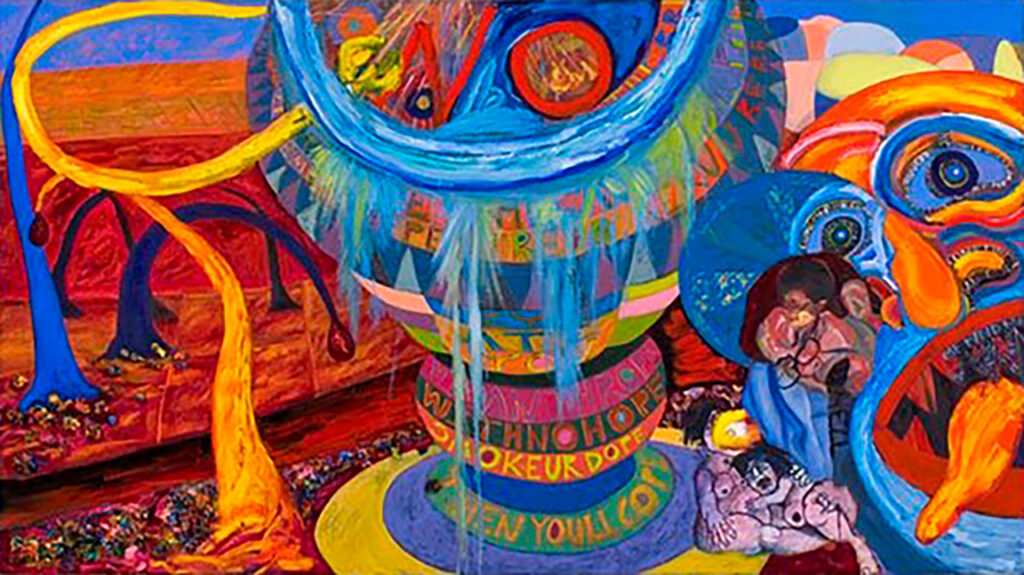
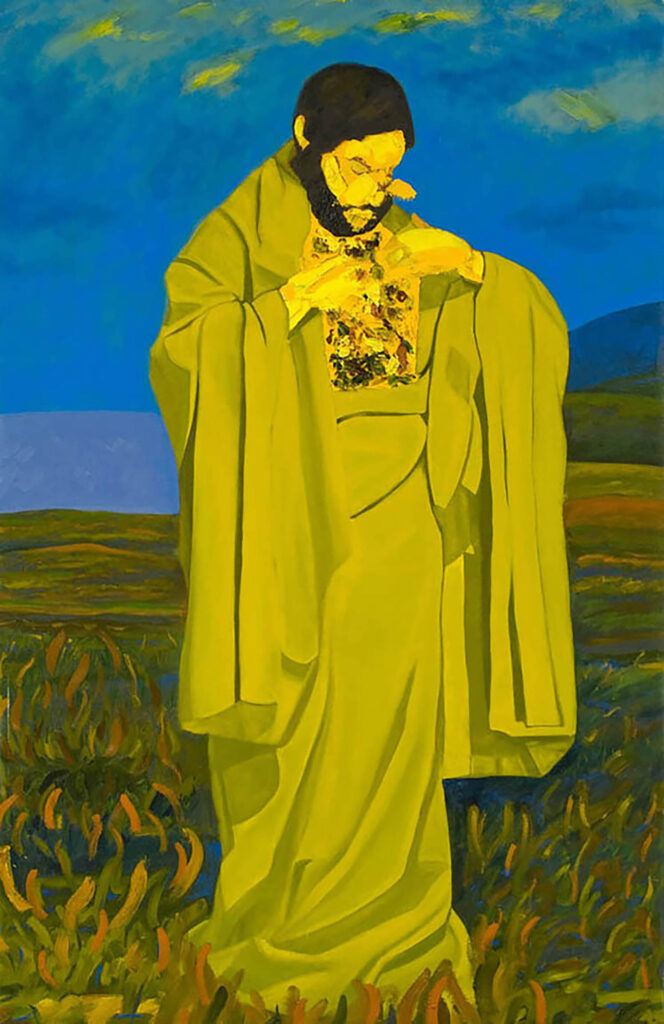
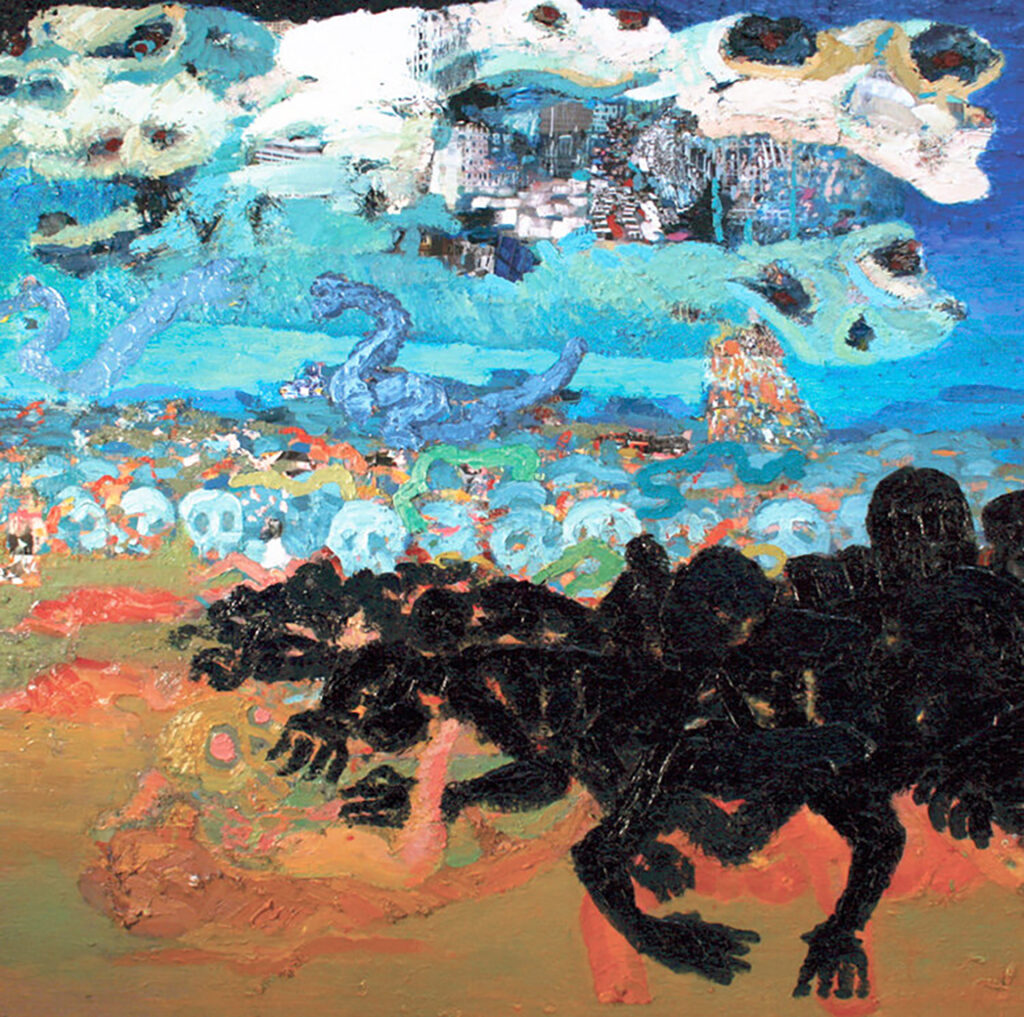
Well, after grad school in 2008, we were hit with the great recession. I made sculptures about living through that and trying to have hope, and that body of sculptures was called A Bright Future, both because of the recession and because the scultpures were kind of meant to live in living rooms as lamps…Like Ralphie’s Dad’s leg sculpture.
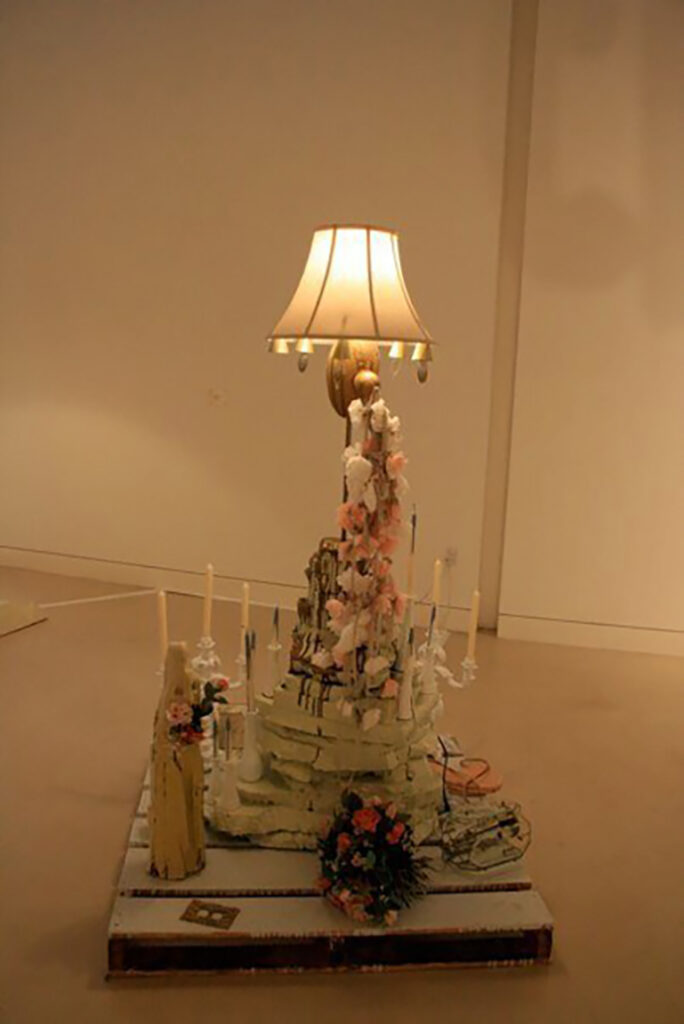
In 2010, I taught at NamSeoul University in South Korea where I experienced a nuclear bomb siren. I was in my office when the alarm blasted through the building. I heard it
through the windows of my office too, and realized that all the buildings were going off with that woooooooooo woooooooo cry. The alarm stopped and I went out and asked a colleague what was going on. She told me not to worry, that North Korea bombed an island off the South Korean Coast. I was like, excuse me? She reiterated that it happens all the time. I was like, what? She said that the siren was a warning that there might be nuclear attack. I was like, huh? She finally said that they’re trying to get money, and it’s a bluff.
That freaking SHOCKED me. I made sculptures from recycled lights that continued A Bright Futures endeavors and aesthetic, but also brought in ideas of Nuclear war. Fission, Fusion, Confusion. Meanwhile, I was having conversations with fellow artists about the history between North and South Korea, and the United States. Some saw the need for Americans in South Korea, but some didn’t, and those conversations in that environment led me to think about my own history as a Nicaraguan American. So, I started thinking about it when I returned in 2011. But it took some nudging, although unbeknown, from Mat Gleason and Max Presniell.

First, Mat Gleason put together a 3 person show in 2012, and 2 of us were Nicaraguan. He asked if we were comfortable with him advertising us as Nicaraguan American Artist, and we both almost jumped out of our shoes. No no no no filled the air, and Mat kindly let the idea go, but he was right. He was on to something. But we were uncomfortable with that idea because we were a small community of 2, she was the first other Nicaraguan Artist I had ever met, and there is discomfort in small numbers. That’s what I assumed, but our unscripted abrupt reaction made me ask myself why was I so reluctant to just say that I was a Nicaraguan American Artist?
The other instance was in the following year in 2013 when Max Presneill included me in that years Sur Bienniel. I would have probably of said no, but because of the reaction I had with Mat, I thought it was probably important for me to participate in an exhibition about Latino Artists. That was a great learning experience for me. I was part of that Sur Bienniels panel discussion at Rio Hondo College. I forget who moderated it, but the question she asked produced a unified answer from the large panel of maybe 10 Latino Artists.
The moderator asked why Latinos as a community weren’t unified in message, or in support for each other. We all agreed that we weren’t one singular community. We were a group of Artists from different Latin countries, with different histories and cultures, and with different personal interests and concerns. Mexico is not Peru, and so on. And it was also ironic to be asked that question because we were literally a group of Latino Artists on the same panel participating in a Bienniel that looked at what Latinos were up to. But that was okay. I gained access to my own story up there in that panel, because I saw that we, as different types of Latinos, were all aware of our differences. I didn’t feel like a party of two Nicaraguans anyone, I felt like an Artist that existed in a pluralistic Post-Modern society, and I was going to be able to delve into the questions that were arising in me about my place in the United States as a Nicaraguan refugee.
That’s what I’ve been doing since. I started learning about the history between Nicaragua and the United States, and basically have been making art that runs along with me as I think about my place in the United States and the Art World. It’s been a bumpy road, and I’m not a scholar, so in the end, my work still is expressionist. My philosophy, and my work, is not didactic, it’s reactive. And as far as I’m into post modernism, it’s not that I’m studying it as an academic or something, instead, I see the freedom all artists have because we live in a pluralistic society. No MAGA, no Abstract Expressionism, no movements, it’s all wide open.
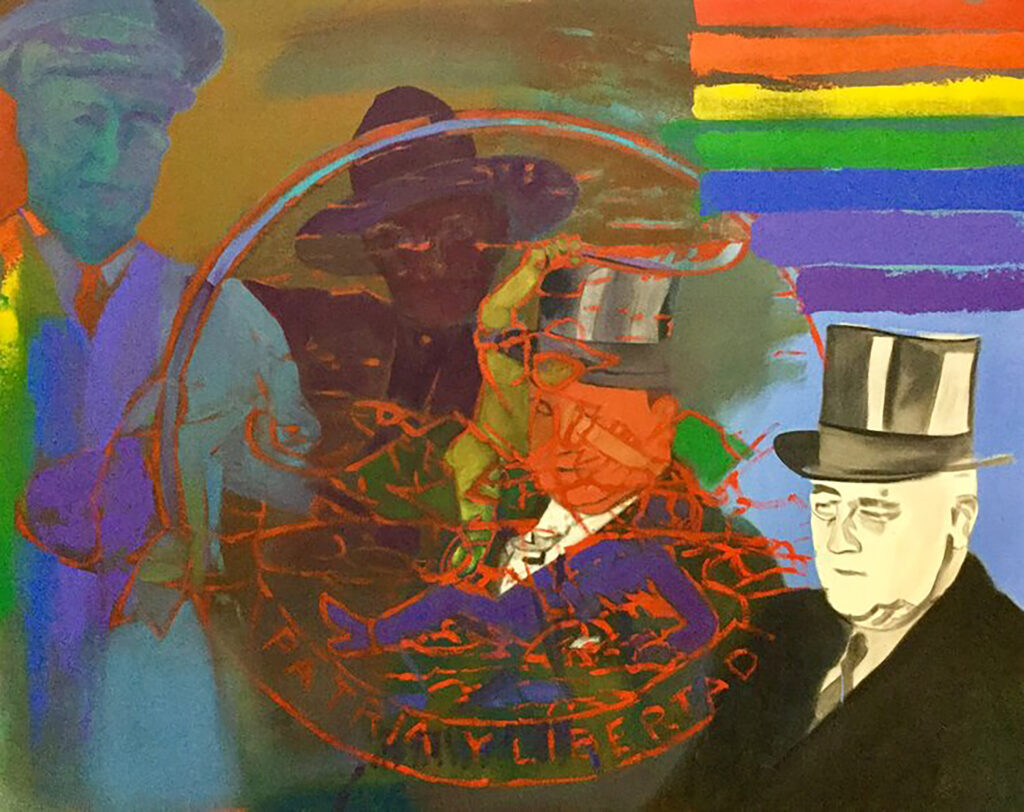
Who or what are your main influences or inspirations in painting?
Like every artist, my list is large, but I think two artists that I go back to a lot for inspiration are Philip Guston, and Louise Bourgeois. I love their use of symbolism and idiosyncratic self expression. Their works are allegorical, filled with personal meaning, and critiques of culture. They aren’t didactic works, they come from a need to work through something.
What do you believe is the role of a painter in today’s society?
I believe that there is a place for every type of painter or artist. The more voices the better.
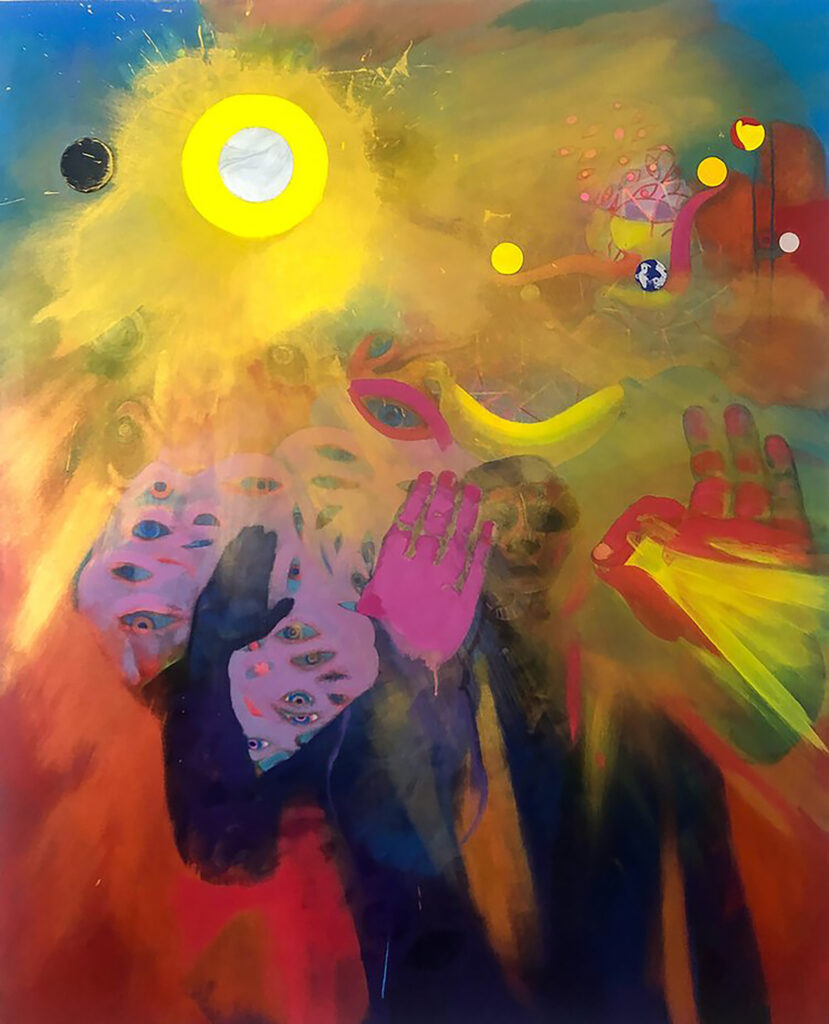
How do you handle criticism and differing interpretations of your work?
I’m a student and I am imperfect. I had to learn about Nicaraguan history, and history shared between Nicaragua and America. I also have to remember my personal visual language, and I have to be open to new symbolism that can enter into my work. I feel like I don’t have a stable vision that can allow me to create the same painting over and over again. I don’t have a base for that kind of confident conformity in my own work. Painting is slow, and I have so many questions and ideas, but I can’t wave a wand to make
everything fall into place. I will need to work through the content, and I am very comfortable with looking like I haven’t found a singular picture to work out from. I’m okay with looking inconsistent. I really had to think about that because it’s not the normal strategy. And at the same time, I think it is the most honest strategy for me, especially in a society that bombards us with images and facts and ideas. This is the first life I’ve ever lived, I’m a sensitive person, I feel existential angst, I have a need for expression, and I’m just one little narrative amongst many. I’m Nicaraguan American, I don’t fully know what that means, I am thinking through my own story. It sometimes feels embarrassing, but then I look for artists that wanted to break open their artistic possibilities.
“There is something ridiculous and miserly in the myth we inherit from abstract art. That painting is autonomous, pure and for itself, therefore we habitually analyze its ingredients and define its limits. But painting is ‘impure. ‘ It is the adjustment of ‘impurities’ which forces its continuity. We are image-makers and image-ridden.”
-Philip Guston
“Art is restoration: the idea is to repair the damages that are inflicted in life, to make something that is fragmented – which is what fear and anxiety to do to a person – into
something whole.
-Louise Bourgeois
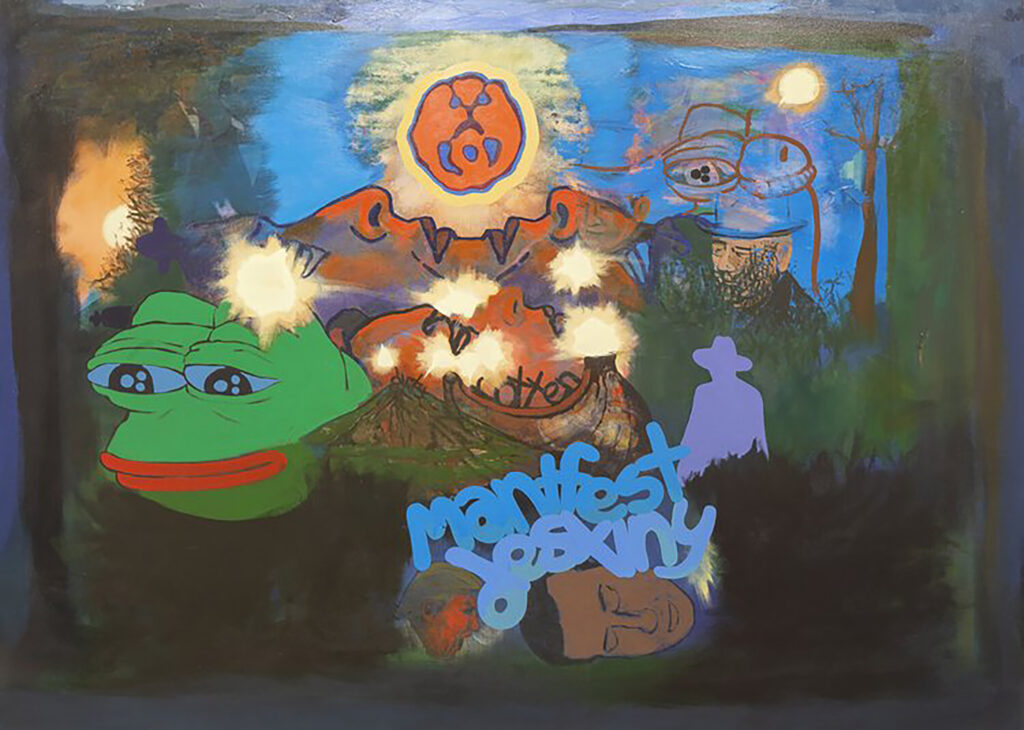
How do you decide on the subjects or themes for your paintings and what materials or tools do you prefer to work with, and why?
I decide on the subjects as my interior story unravels, and paint is my medium. I love it’s history, it’s malleability, it’s objectness, and magic. I’m a visual person.
You have a new show opening at Mount Saint Mary’s University in Los Angeles. The title of the exhibition is My Little Narrative, and it will be at the Jose Drudis-Biada Art
Gallery from October 3rd to November 11th. The reception will be on October 7th, 3pm-5pm What’s the central theme or inspiration behind your upcoming show?
Phil Goldwhite, who is a fantastic artist, and a Professor and Curator at MSMU, curated this show with the idea of exhibiting work ranging from 2018 to the present. I believe he sees the underlying narrative, or concerns, in my work since 2018. He understands the synthesis of Nicaraguan and American history with my personal visual imagined language, and cultural symbolism, and how it all comes together. Keep in mind, I’m guessing all this from the studio visit we had. I like to think of these paintings that will be included as psychological poetic moments. I’m really thankful to Phil because I have always wanted to see this show for myself, so when he asked me and told me his vision, I was pretty speechless. I titled the exhibition “My Little Narrative” to reference Lyotard’s Petit Resit.
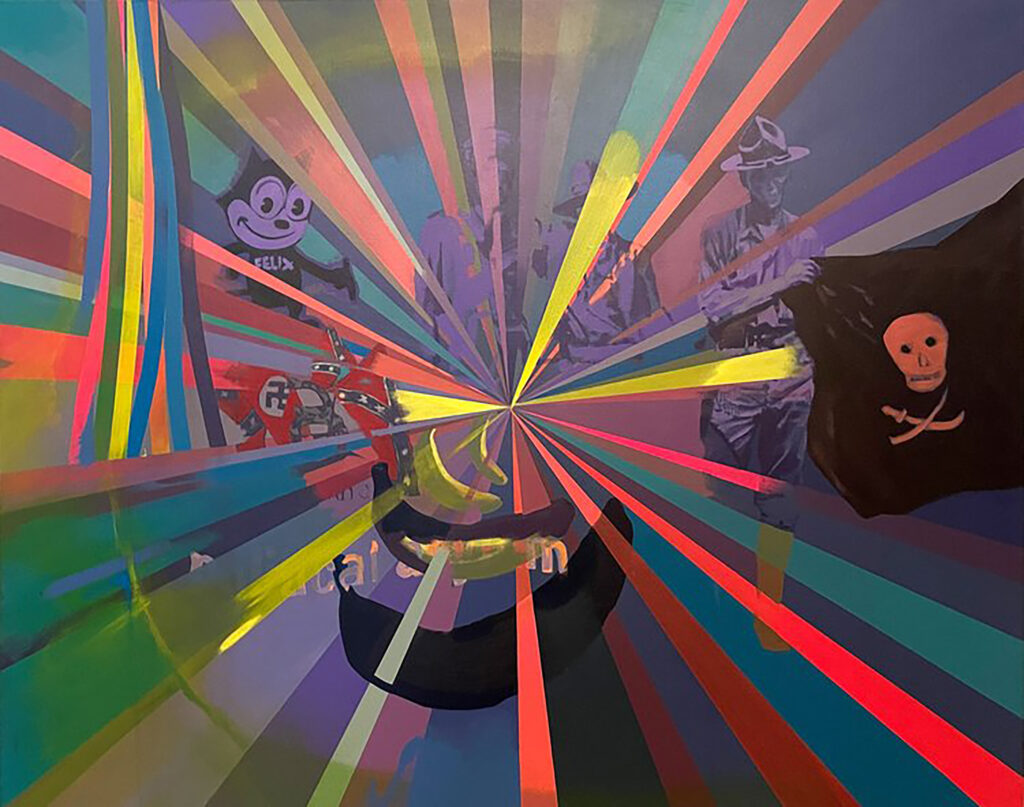
How long have you been preparing for this show, and what has been the most
challenging aspect of the preparation?
I’ve been preparing all my life. Haha. No. I was fortunate to have work ready to go, and since finding out about the show, I just continued working. I have a beautiful family and also teach, and if I’m not tending to one or the other, I am painting. And to be perfectly honest, the hardest thing for me is to get out to art shows, which I think is part of the preparation. It’s something I desperately want to change. I love artists, I love hearing them speak, I love how they think, and I love having them over my studio.
How do you hope the audience will react or engage with the works in this show?
I hope they see the different styles and compositions as a positive. I hope they see the struggle and dedication, and most importantly, I hope they find beauty in it.
Were there any new techniques or styles you experimented with for this exhibition? Styles, techniques, images and compositions are all symbolic to me, so I use anything if it
meets my requirements or it demands to be included.
How do you balance personal expression and the expectations of your audience or the
art market?
I am trying to find representation, so what that means is finding an organization that sees the value of my work. That is a question I wrestle with. I’ve thought about “how can I switch visual modes so often and not be seen as inconsistent?” And as I mentioned before, I’m okay with being perceived that way. Not because I want to be isolated, or different, but because I think that is the most honest, and post modern, approach I can offer.
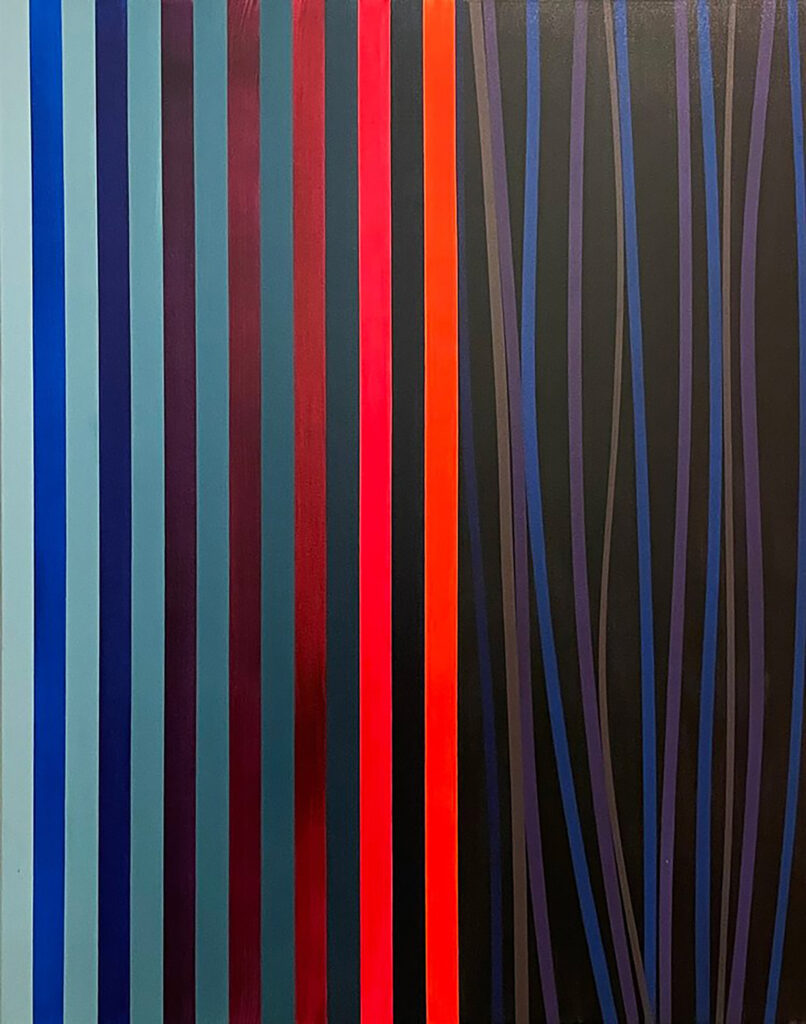
What advice would you give to young artists who are just starting out?
A few things Professors once told me, “You don’t have to be drunk to be an artist!” “You have to be tough as nails.” And one I need to work on, “Be involved with your Art
Community.” And take care of all your work!!! Don’t throw stuff away.
What’s next for you after this show? Are there new themes or techniques you’re eager to explore?
I’m going to continue working in the same way, and some things that I’m thinking about more nowadays are Liberation Theology, El Gueguense, and thick expressive paint strokes. And I want to produce more!
Thank you Walpa!



Macha Suzuki
Posted at 10:55h, 20 SeptemberReally great interview! Love Walpa’s work!